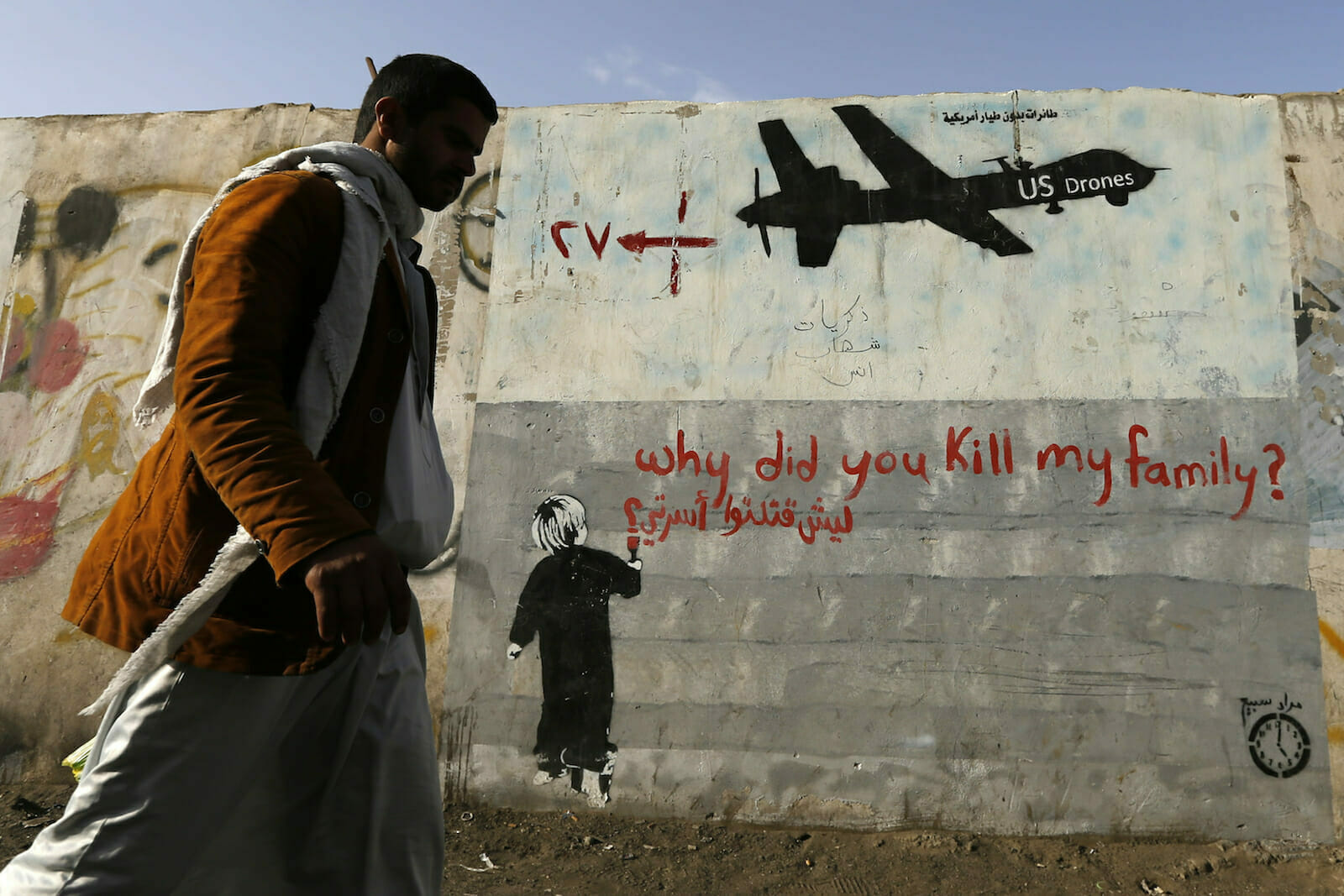
Terrorists and the Weaponization of Drones
Islamic State (IS) has been actively using drones since 2014 to conduct reconnaissance on enemy positions and capture aerial footage of attacks for use in propaganda videos. It has also used drone video feeds to adjust fire from mortars, artillery guns, and rockets against static targets. The group gradually shifted to using drones for offensive purposes as well, either for guided airborne bombs or as vehicles to carry and drop ordnance on enemy targets, which, of course, raises fears that it may attempt to do the same outside of Iraq and Syria since its safe havens have disappeared.
The IS drone program’s early successes owe much to the chaos, lawlessness, and failed state status of Iraq and Syria. Mosul, in particular, was an ideal place for IS to conduct drone operations, especially with the small, commercially available drones that the group tends to use. The city offered a close-quarters urban combat environment where the battle’s front lines could be across the river, across the street, or just in the building next door. Enemy troops were never too far away to be in a position to deploy limited range small drones. Since drone controls use radio frequency emitters, they are easy to identify and track down, which is one reason why IS militants often operated drones from homes or mosques, surrounding themselves with civilians.
Most of IS’s drone attacks have involved lightweight military ordnance such as grenades, rocket warheads, and bomblets from cluster bombs, occasionally modified to improve accuracy. Due to drones’ limited carrying capacity, these strikes do not yield the same destructive power that mortar or heavier artillery fire could, but they allow for more precision than mortars or makeshift rocket launchers can provide. The group’s attacks rattled Iraqi troops enough that the Iraqi government requested jamming equipment from the U.S. in an effort to prevent drone strikes. As the battle for Mosul dragged on, however, the strikes became less frequent. Even though the drones that IS used were widely available, the group found it difficult to replace those it had because of Mosul’s perpetual ‘siege’ environment before it was captured by Iraqi forces in 2017.
It is probably only a matter of time before an IS supporter attempts a drone attack in the West, given the group’s influence over grassroots jihadists and the attention its drone operations have received in propaganda and media coverage. In many respects, it is surprising this has not already happened, given how many ‘homegrown’ IS sympathizers there are in the West. Hezbollah, with the help of Iran, has developed the most advanced drone capability of any terrorist group in the world and used drones against Israel and rebels in Syria. Lacking Hezbollah’s state-sponsored military drone capability, most aspiring terrorists have to make do with commercially available drones, which will limit the scale and efficacy of prospective attacks.
A grassroots drone attack would probably prove far less deadly than a mass shooting or vehicular attack simply because manufacturing lightweight but deadly drone munitions is so difficult. Drones would be an ideal way to disperse biological weapons; however, if a drone attack were conducted in a large crowd, the panic it would generate may well cause more injuries than the device itself. Even though terrorist attacks using drones are likely coming, their physical impact should generally be limited.
Spray drones (with a range of several miles) would be relatively easy for terrorists to obtain. However, it is one thing to have a sprayer drone, but quite another to actually be in a position to use it with toxic chemicals or nuclear materials. That said, any weapons of mass destruction offered online is likely to be a sting operation by the government authorities, so IS (or other such groups) is forced to import the material, then contain it safely, deliver it undetected to its destination, load it without prematurely martyring their team, and successfully take off and deliver the material to its intended target. It is not such an easy thing to do, which is presumably a big part of the reason why it has not yet happened. On the other hand, using toxic materials that do not require importation and might even be purchased locally would improve their chances of success significantly.
A long list of militant organizations have acquired drones and attempted to modify them for their own purposes. Hezbollah has repeatedly used drones to probe Israel’s air defenses, and the group released video in 2016 that appeared to show a drone dropping Chinese-made bomblets on Syrian rebels. Al Qaeda operatives in Pakistan commissioned an avionics engineer to build small attack drones and conducted at least one successful test flight before the program was discovered by police in 2013. Terrorist leaders launched appeals in 2016 for scientists and engineers to travel to Iraq and Syria to work on weapons programs, including drones. At the time, a group of pro-IS technicians used the social media platform Telegram to discuss how common engine parts might be adapted for use in missiles or in military-style attack drones.
At least a few technical experts appear to have responded to the call. When government troops recaptured the Iraqi provincial capital of Ramadi, in 2016, they discovered a small workshop where workers were attempting to manufacture drone parts from scratch. Photographs from inside the facility showed homemade wings and fuselage parts, as well as electronics, camera controllers, and gyro sensors used to control flight. Similar factories built to modify commercial drones were found in liberated parts of Mosul, all pointing to the increasing use of weaponized drones. Islamic State initially favored small ¬helicopter-like drones with four rotors and sufficient lift to carry a small bomb, usually a mortar shell or similar device with stabilizing fins and a point-detonating fuse built to explode on impact. Subsequent attacks involved fixed-wing drones of uncertain origin.
During the Syria conflict, IS’s lightweight drones were nowhere close to matching the sophistication and lethal power of the Predators and Reapers used by the US military. Yet, despite their limited operational effect on the battlefield, the drones had forced coalition troops to take countermeasures against them, including early-detection systems and electronic jamming, while also requiring that coalition forces spend resources to search for factories and staging areas where the drones are readied for use on the battlefield.
When Iraqi troops captured drone facilities in Mosul, in 2017, they discovered scores of documents detailing an elaborate procurement system for purchasing the aircraft and parts, as well as extensive procedures for altering and testing the equipment. The records addressed the group’s efforts to secure, modify, and enhance the range and performance of its drones. When the siege of Mosul began in the fall, IS fighters stepped up their use of small surveillance drones to gather intelligence and showcase their efforts to defend the city, producing mini-documentaries with aerial footage of successful suicide attacks on Iraqi troops. The shift to weaponized drone attacks began late in 2016 and was ramped up dramatically by 2017.
The documents showed IS’s efforts to acquire predictable items like GoPro cameras, memory cards, GPS units, digital video recorders, and spare propeller blades. They also illustrated the group’s efforts to secure, modify, and enhance the range and performance of its fleet of drones. To protect the transmission of their drone video feeds, members of the group wanted to acquire encrypted video transmitters and receivers. A long-range radio-controlled relay system was also included on a number of its ‘acquisition’ lists (to extend the range of its drones), as were various types of servo motors.
While servo motors can be used for a variety of drone-related tasks, they can also be used to facilitate release mechanisms, such as the release of a munition from a drone, a tactic with which the group appeared to have become quite proficient. The inclusion of these types of items demonstrates how, even though the drone material being requested by IS was something that a sophisticated high schooler could put together, some of these items can be used for more sinister purposes. The documents did not reveal how IS actually acquired the material found on the lists, but given the specific price information provided on the forms IS used to order the material, it is possible that IS was acquiring at least some of the equipment online, or likely through third parties in countries outside the region, including popular online retailers.
All this points to a future in which terrorists will use drones to enhance their ability to attack targets in their own war zones, and beyond. Whether or not the Houthis in Yemen were responsible for the attack on the Saudi oil installation this past weekend, terrorist groups throughout the world either have or want to have, similar technological capabilities to carry out such audacious attacks. The sad reality is that there is not a lot that can be done to stop them at the present time. Low-flying drones cannot be detected by radar and can carry a lethal payload. It is now up to the military technologists to develop effective counter-measures if they can.

